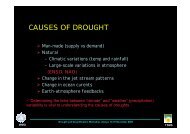Model ComponentsForecast:This represents the final product for which NWP was ultimately developed. The format, meteorologicalvariables, forecast period, and frequency are driven by customer needs.Verification:Forecasters use model verification data to identify specific limitations and statistical biases of modelguidance and to compensate for them. Modelers use verification data to help identify deficiencies sothey can improve forecast model components. Model verification is an integral part of the NWPdevelopment process.Forecast Process:In the forecast process, model output and current observations are combined with the forecaster'sunderstanding of meteorological principles to develop a forecast for the area of responsibility.Centralized subjective guidance is used to help with specialized aspects of the forecast. Themeteorological variables required in the forecast and the customer needs drive the types of guidanceproducts and observations used in the forecast development process.Understanding Meteorological Principles:A thorough understanding of basic meteorological principles and relationships is necessary tointelligently use model guidance so one can, for example, identify when model output is notmeteorologically sound or consistent. As models become more complex and predict more detailed andrealistic-looking features, there is a greater need to understand meteorological principles in order tointelligently take advantage of NWP and avoid being misled. Knowledge of local climatology, terraininfluences, and model performance in the local area is also important to developing the best possibleforecast.Observations:Observations of all types are needed to ascertain current atmospheric conditions and to evaluate theaccuracy of a model's analysis or forecast. Observations provide the ground-truth data and are used tohelp assess the reliability of model output and to make necessary adjustments.
Model ComponentsCentralized Guidance:Using all of the forecasting tools at their disposal, NCEP meteorologists produce subjective, centralized guidanceproducts, such as hurricane track predictions, severe weather outlooks and discussions, and quantitative precipitationforecasts. These products are added to the mix of tools and resources used by forecasters.Numerical Guidance:Numerical guidance products are produced through postprocessing of the model output. They are in a form that can bereadily used by forecasters and are usually displayed on a grid with a different resolution than the original model.Examples include geopotential height charts, MSL pressure, and surface temperature. Aircraft turbulence and icingcharts are examples of fields calculated from numerical model output using physically based empirical relationships.Statistical Guidance:Some sensible weather elements, such as visibility and thunderstorms, are not predicted by the model and cannot bederived directly from the model forecast variables. Other parameters, such as surface maximum temperature, aresensitive to model weaknesses and vary locally. Statistical techniques, such as Model Output Statistics (MOS), have beendeveloped to predict weather elements at particular point locations from direct and postprocessed model fields andother pertinent data, including climatology.Direct Model Output:Direct model output typically refers to gridded forecast data provided at each model grid point and vertical level. Thesedata are not interpolated for locations between model gridpoints and levels. The output data are used by forecasters todevelop a wide variety of local forecast and diagnostic products and provide a look inside the model.Model Output:Model output products include all products that use model fields. The model forecast variables can be looked at directly,postprocessed into grids, plots, station predictions, etc., and used in combination with climatology and other datasources in statistical forecasts. Collectively, they are an important part of the forecast process.Postprocessing:In postprocessing, computations are made to the raw model output to transform it to a format readily usable byforecasters. Diagnostics and meteorological parameters are derived from the forecast variables. In addition, modelvariables are interpolated vertically to surfaces used by forecasters (isobaric, isentropic, and constant altitude) andinterpolated horizontally to forecast locations or output grids. Contour plots are also made. Additional postprocessing,such as using AWIPS algorithms, may be done later. The resulting products are collectively referred to as "numericalguidance."Physics:In NWP, physical processes refer to three types of processes:Those operating on scales smaller than the model resolution but which exert a cumulative effect felt at resolvable scalesThose involving exchanges of energy, water, and momentum between the atmosphere and external sources (forexample, radiation and land and sea surface processes)Cloud and precipitation microphysics
















